Crown Jewels of Conservation
These projects represent some of DU's finest work on North America's most important waterfowl landscapes
These projects represent some of DU's finest work on North America's most important waterfowl landscapes
Edited by Emily Robinson
Since 1937, Ducks Unlimited has had one mission: to conserve wetlands and associated habitats for waterfowl, other wildlife, and people. Dynamic and responsive leadership by DU's volunteers and staff has assured that the organization's work has evolved in response to the ever-changing pressures on waterfowl and the habitats upon which they depend throughout their life cycle. From the extreme northern reaches of the Arctic and Boreal Forest to the unique mangrove wetlands of Mexico-and the thousands of miles in between-waterfowl rely on a wide variety of habitats as they wing their way across North America each year. To ensure that Ducks Unlimited invests wisely in the future of waterfowl, DU's science staff has worked closely with a host of conservation partners all over this continent to determine the highest-priority landscapes for waterfowl. It is on these landscapes that DU has concentrated its efforts for nearly eight decades, conserving more than 13.8 million acres of habitat for waterfowl and other wildlife.
As DU's 80th anniversary approaches, staff from all four of the organization's regional offices as well as those from Ducks Unlimited Canada and Ducks Unlimited de Mexico have provided a selection of exemplary conservation projects on North America's most important landscapes for waterfowl. These projects, which were delivered in cooperation with DU's valued partners, not only provide crucial habitat for waterfowl but also offer many ecological, social, and economic benefits, including public access for hunting, fishing, and wildlife watching.
Saskatchewan
Lamb Family Farm
The lush, rolling landscape of Saskatchewan's Allan Hills is a cattle rancher's dream. It's what drew Alberta residents John and Kim Lamb and their family to the area more than a decade ago to expand their livestock operation. Recently the Lambs took a major step toward bringing together agriculture and waterfowl conservation by signing the largest conservation easement in Ducks Unlimited Canada's history, protecting 3,282 acres of native parkland, tame forage, and natural and restored wetlands-all important habitats for ducks and geese. Wetland-rich prairie landscapes like the Allan Hills can support as many as 60 breeding pairs of ducks per square mile. This means that habitat on the Lambs' farm is prime real estate for waterfowl. Safeguarding this habitat ensures a strong, sustainable future for all those that depend on the land-the Lambs, their cattle, and the ducks.
Project Partners
The Lamb Family, Government of Canada's Natural Areas Conservation Program administered by Environment and Climate Change Canada, North American Wetlands Conservation Act (NAWCA), and several private donors
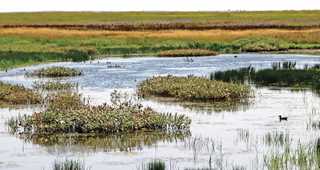
Phillips County, Montana
Pintail Flat
Montana is a key breeding ground for several species of waterfowl. The sparsely populated Hi-Line region in the north-central part of the state boasts some of the highest wetland densities on the prairies. Because of the Hi-Line's immense value to waterfowl and other wildlife, Ducks Unlimited has stepped in to address a growing concern in this region: escalating grassland conversion. By working with landowners to protect the Hi-Line's best habitat, DU will also help maintain the region's ranching heritage.
Through its Revolving Habitat Program, DU conserves vital waterfowl habitats at risk of conversion by purchasing land, restoring degraded habitats, and protecting the area with conservation easements. The land is then resold to a conservation buyer, typically a local rancher. DU will protect the 1,760-acre Pintail Flat property in Phillips County through this program. Encompassing extensive grassland and numerous seasonal wetlands, this parcel is adjacent to waterfowl production areas, national wildlife refuges, and other major wetland complexes important to breeding waterfowl. DU is also working with its partners to ensure perpetual grassland management and public access for hunting on the property.
Project Partners
Montana Fish, Wildlife and Parks and U.S. Fish and Wildlife Service (USFWS) Wildlife Restoration Program
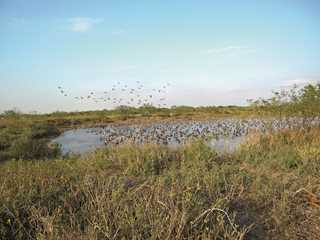
Tamaulipas
Rancho Los Ébanos Project
Laguna Madre in Tamaulipas is one of Mexico's richest aquatic ecosystems. Due to its geographic location and unique mix of wetland habitats, Laguna Madre hosts a wide variety of resident and migratory waterfowl and other wetland birds, including more than one-third of North America's redheads during winter. A significant portion of the Laguna Madre watershed has been converted to agricultural land, which has resulted in the loss of many freshwater wetlands. As part of a 2012 initiative to conserve these key habitats, Ducks Unlimited de Mexico (DUMAC) launched a project to restore and manage freshwater wetlands as wintering habitat for migratory waterfowl on Rancho Los Ébanos, a private property southeast of Laguna Madre, in the municipality of San Fernando, Tamaulipas.
The project's main objective was to build infrastructure to channel agricultural drainage into a series of basins connected by spillways and channels. DUMAC constructed 2.3 miles of channels and reinforced concrete retention dikes to carry water to this project's various wetland basins and to keep the water from flooding adjacent land. Two concrete spillways were built to ensure that once each basin reaches its maximum water level, the excess water will flow into adjacent shallow wetlands to provide extensive habitat for wintering waterfowl and other wildlife.
Project Partners
NAWCA, Ducks Unlimited Inc., and private landowners

Northwest Territories
Dinaga Wek'ehodi
Stretching from western Alaska to the Canadian province of Labrador, North America's Boreal Forest is part of the world's largest land-based ecosystem. Much of the Boreal is composed of wetlands, and in some years up to 40 percent of the continental duck population breeds in this vast and largely unspoiled region. Billions of other birds also rely on habitats in the Western Boreal Forest. However, increasing natural resources development and other impacts have made this region among the most threatened waterfowl areas on the continent.
In 1997, Ducks Unlimited founded the Western Boreal Forest Initiative to help identify and conserve wetlands and other waterfowl habitats in the region. DU and its partners work closely with natural resource managers in the public and private sectors to ensure that development activities have minimal impact on wetlands, watersheds, and waterfowl populations. DU's current efforts in the region are focused on land-use planning, land-cover inventory and mapping, waterfowl surveys, wetland and waterfowl productivity research, and hydrologic and wetland risk mapping.
Great progress has already been made in protecting key waterfowl habitats in the Western Boreal Forest. For example, Dinaga Wek'ehodi (pronounced dee-na-ga wek-a-ho-dee) is a newly protected National Wildlife Area in the Northwest Territories. The area encompasses approximately 150,000 acres in the North Arm of Great Slave Lake and is located primarily within the T'licho First Nation settlement region. This pristine area provides staging and breeding habitat for millions of waterfowl and other migratory birds annually and is designated as a key migratory bird habitat site by Environment and Climate Change Canada.
Project Partners
Ducks Unlimited Canada, The Pew Charitable Trusts, Canadian First Nations, The William and Flora Hewlett Foundation, Gordon and Betty Moore Foundation, and Progressive Boreal Industries
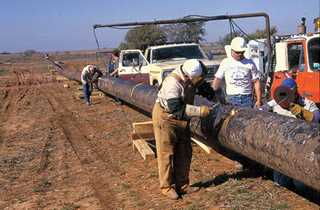
Oklahoma
Hackberry Flat Wildlife Management Area
In the early 1900s, residents of Tillman County, in southwest Oklahoma, used shovels and mule teams to drain a historical wetland basin. They built a massive ditch that measured four miles long, 20 feet deep, and 40 feet wide. Prior to being drained, the flood-prone area, known as Hackberry Flat, attracted scores of waterfowl and hunters, including President Theodore Roosevelt. Although the land was fertile, farming the wet landscape proved exceedingly difficult.
Wetland restoration efforts began in 1993, when the Oklahoma Department of Wildlife Conservation started purchasing land from willing sellers to form what would become Hackberry Flat Wildlife Management Area (WMA). Ducks Unlimited helped break ground on wetland management infrastructure in 1995 and enhanced a total of 3,700 acres of wetlands on 25 units within the WMA by constructing 35 miles of dikes, four miles of water distribution canals, and approximately 90 water-control structures. The WMA is a popular public hunting destination for waterfowlers.
Project Partners
The Williams Companies Inc., USDA Natural Resources Conservation Service (NRCS), NAWCA, City of Frederick, USFWS Wildlife Restoration Program, U.S. Bureau of Reclamation, Phillips Petroleum Company Inc., National Fish and Wildlife Foundation (NFWF), Tillman County Commissioners, First Southwest Bank, Pioneer Trucking, Wildlife Forever, Arrow Trucking, Oklahoma Station Chapter of Safari Club International, Oklahoma City Sportsman's Hunting Club, and U.S. Geological Survey

New Jersey and Delaware
Delaware Bay Projects
The coastal wetlands of Delaware Bay provide crucial staging and wintering habitat for waterfowl, including notable species such as American black ducks and Atlantic brant. Ducks Unlimited has a long history of conservation on the 800-square-mile bay, which continues today through several large projects. In coastal New Jersey, for example, DU is purchasing 200 acres of land to turn over to the New Jersey Division of Fish and Wildlife (NJDFW) for inclusion in the state's WMA system. On Bombay Hook National Wildlife Refuge in Delaware, DU and the USFWS are working together to enhance more than 500 acres of emergent wetland habitat. And on Ted Harvey Conservation Area, restoration work is expected to begin this fall on a 375-acre wetland on one of Delaware's most productive public waterfowl hunting areas.
DU's past achievements on Delaware Bay include the restoration of 87 acres of intertidal emergent wetlands on Cox Hall Creek in Cape May County, New Jersey, and a 343-acre project encouraging the reestablishment of bald cypress and Atlantic white cedar trees in Delaware's unique Great Cypress Swamp.
Project Partners
American Littoral Society, Atlantic Coast Joint Venture, Cape May County Department of Mosquito Control, Cape May County Planning Department, Delaware Center for the Inland Bays, The Conservation Fund, Delaware Department of Agriculture, Delaware Agricultural Lands Preservation Foundation, Delaware Department of Natural Resources and Environmental Control Division of Fish and Wildlife, Delaware Wild Lands, NFWF, The Nature Conservancy, USDA NRCS, New Jersey Conservation Foundation, NJDFW, New Jersey Division of Environmental Protection Green Acres Program, New Jersey Natural Lands Trust, New Jersey Waterfowlers Association, NAWCA, private donors, and USFWS
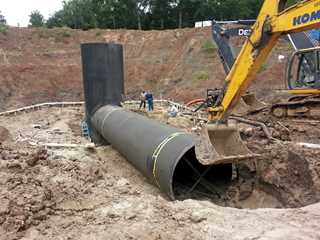
Louisiana
Russell Sage Wildlife Management Area
In 2014, Ducks Unlimited and the Louisiana Department of Wildlife and Fisheries repaired water-management infrastructure and installed the largest pump in DU's history on one of northeast Louisiana's most popular public waterfowl hunting areas. The restoration project enhanced management capabilities on a 1,900-acre green-tree reservoir on Russell Sage WMA, near Monroe. In addition to the obvious benefits to waterfowl and hunters, wetland enhancement projects like this one have tremendous benefits for the community and the environment in general. By slowing the flow of water draining from the reservoir into Bayou Lafourche, the WMA's water-control structures allow nutrients such as nitrogen and phosphorus to be absorbed, improving water quality downstream. Additionally, sediment has ample time to settle, improving water clarity.
Project Partners
Louisiana Department of Wildlife and Fisheries, NAWCA, USFWS, Wetlands America Trust, Tunica-Biloxi Tribe of Louisiana, The Wetlands LLC, Matt and CeCe Stuller and the Stuller Family Foundation, and DU Major Sponsors
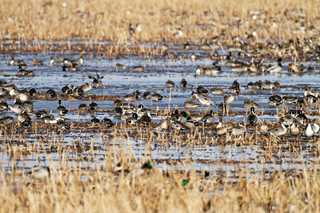
Texas
J.D. Murphree Wildlife Management Area
Owned and managed by the Texas Parks and Wildlife Department (TPWD), J.D. Murphree WMA consists of 24,498 acres of fresh, intermediate, and brackish marsh within the prairie-marsh zone of Texas's upper coast. These wetlands are part of the Chenier Plain, the westernmost delta of the Mississippi River, which extends from Vermilion Bay, Louisiana, to Galveston Bay, Texas. Ducks Unlimited and the TPWD have worked closely together on several wetland enhancement and restoration projects on the WMA, located near Port Arthur. In one of the largest beneficial-use projects of its kind, more than 3 million cubic yards of dredge material were transported from the Golden Pass Liquefied Natural Gas terminal dock along the Sabine-Neches Waterway to designated areas within the WMA's Salt Bayou Unit. As much as 24 inches of dredge material was placed on top of subsided marsh to raise elevations in the restored area. Increasing the elevation of Salt Bayou marsh has allowed native wetland vegetation to become re-established, restoring 1,300 acres of coastal marsh for waterfowl and other wetland-dependent wildlife.
Project Partners
TPWD, Golden Pass Liquefied Natural Gas, DU Major Sponsors, and the National Oceanic and Atmospheric Administration

California
Gray Lodge Wildlife Area
Located on the northern end of California's Central Valley, Gray Lodge Wildlife Area is one of the most important wetland complexes in the Pacific Flyway. The 9,189-acre area is owned and managed by the California Department of Fish and Wildlife and hosts up to 1 million ducks and 100,000 geese during the winter, as well as more than 60,000 visitors per year. Ducks Unlimited has been involved in conservation efforts on Gray Lodge Wildlife Area for many years. In 2015, DU completed construction on a wetland restoration project on Fields 55, 56, 57, and 59 in the wildlife area's northeast section. Project work, which was designed and supervised by DU, involved regrading ponds to improve natural water flows and increase water distribution, water-use efficiency, water conveyance capabilities, and upland cover.
Project Partners
California Department of Fish and Wildlife, California Wildlife Conservation Board, and De Witt Brothers & Company
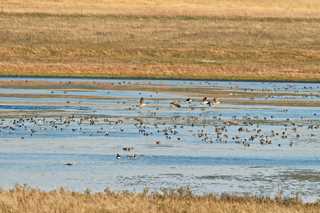
Southern Oregon/Northeastern California
Lower Klamath National Wildlife Refuge
Lower Klamath National Wildlife Refuge (NWR), listed in the National Register of Historic Places as a national historic landmark, was established by President Theodore Roosevelt in 1908 as the first waterfowl refuge in the United States. Composed of 50,092 acres of intensively managed shallow marshes, open water, grassy uplands, and croplands, Lower Klamath NWR is one of the most biologically productive refuges in the Pacific Flyway. Up to 80 percent of the flyway's migratory waterfowl pass through the Klamath Basin in fall and spring, and approximately 50 percent of these birds visit the refuge during their journey.
Continuing to build on a long history of conserving habitat within Lower Klamath NWR, DU completed phase two of the 2,100-acre Miller Lake Restoration and Enhancement Project in 2012. This effort included conducting a topographic survey, preparing an engineering plan, and delivering project construction.
Project Partners
The Joseph and Vera Long Foundation, NAWCA, and USFWS Pacific Northwest
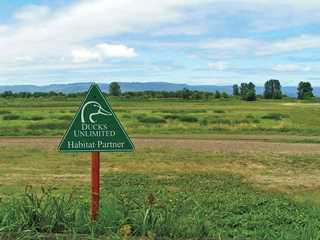
Located along the Columbia River just northwest of Portland, Sauvie Island is one of the largest river islands in the United States. Designated as an Important Bird Area by the National Audubon Society, the wetlands of Sauvie Island support impressive numbers of migrating and wintering waterfowl as well as offering significant breeding and brood-rearing habitat for mallards, wood ducks, and cinnamon teal. The area also provides excellent public hunting opportunities.
For more than a decade, Ducks Unlimited has played a major role in conserving waterfowl habitat on Sauvie Island Wildlife Area, completing 16 projects encompassing 3,200 acres of habitat. Many of these projects have focused on improving water-management and water-delivery capabilities. The primary funding source for this work was $2.5 million in NAWCA grants, which were leveraged in part by contributions from DU Major Sponsors.
Project Partners
Oregon Department of Fish and Wildlife, USFWS, NAWCA, and DU Major Sponsors
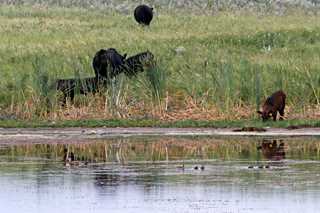
New York
St. Lawrence River Valley
Because of the St. Lawrence River Valley's productive mix of native grasslands and wetlands, this region of New York is an important breeding landscape for ducks and a vital migration stopover for Atlantic Flyway waterfowl. Ducks Unlimited and its partners have made a tremendous impact on the St. Lawrence River Valley over the past 10 years, utilizing nearly every conservation tool available to improve wetland habitat.
DU is currently partnering with Thousand Islands Land Trust to protect, restore, and enhance 2,133 acres of marsh habitat, forested wetlands, grasslands, and forests through a $1 million NAWCA grant. The project will also protect 12 miles of undeveloped shoreline and river corridors. In 2013, DU worked with two private landowners in Jefferson County, New York, to protect more than 300 acres of crucial wildlife habitat by securing a conservation easement on their properties. Additionally, DU and its partners were awarded a Great Lakes Restoration Initiative grant in 2010 to protect 522 acres of high-quality wetlands in the St. Lawrence River Valley. These wetlands support several species of waterfowl, diverse fish populations, and an array of other wildlife.
Project Partners
Thousand Islands Land Trust, NAWCA, and private landowners
Ducks Unlimited uses cookies to enhance your browsing experience, optimize site functionality, analyze traffic, and deliver personalized advertising through third parties. By continuing to use this site, you agree to our use of cookies. View Privacy Policy